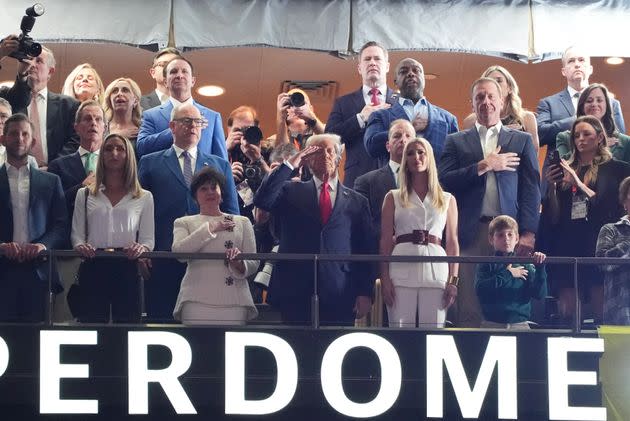Super Bowl LIX at the Caesars Superdome in New Orleans marked a historic moment as President Donald Trump became the first sitting U.S. president to attend a Super Bowl. However, his presence during the national anthem sparked mixed reactions from the crowd, igniting a debate among fans and social media users alike. While many viewers witnessed what appeared to be a rapturous reception for the President, others questioned whether his moment on the big screen was met with genuine applause or, alternatively, with covert disapproval.
A Historic Attendance and the National Anthem
As the Kansas City Chiefs prepared to face the Philadelphia Eagles in a high-stakes matchup on February 9, 2025, anticipation was high not only for the on-field action but also for the cultural milestones surrounding the event. Among these was the fact that President Trump had made history by being the first sitting president to attend the Super Bowl. This unprecedented attendance added an extra layer of significance to the game, turning the event into a focal point for both sports enthusiasts and political observers.
During the pre-game festivities, Grammy-winning musician Jon Batiste delivered a stirring rendition of the national anthem. As Batiste’s powerful vocals filled the stadium, cameras captured a moment that would soon become a subject of intense discussion: the screen briefly panned to reveal President Trump taking his seat among the crowd. While many viewers noted that the President appeared to be greeted with enthusiastic cheers, some social media users speculated about whether the response was as unequivocal as it seemed.
Mixed Reactions Captured on Social Media
In the minutes following the national anthem, a flurry of reactions emerged on social media platforms. One Twitter user commented humorously, “Y’all didn’t boo at Donald Trump loud enough,” suggesting that a portion of the audience might have been less enthusiastic than they appeared at first glance. Another user expressed frustration, stating, “That was pretty s**tty to show Trump during Jon Batiste singing the National Anthem; it forced me and half of America to boo.” These contrasting tweets underscore the divided nature of the crowd’s reaction—some viewers interpreted the moment as a genuine show of support, while others felt it was indicative of a more complex sentiment.
Adding to the debate, several users questioned whether the reaction was a clear boo or if it might have been a mix of cheers and jeers that was difficult to decipher on camera. Comments like “Did they cheer or boo Trump? Difficult to tell,” and “Did they boo or cheer Trump at the #SuperBowlLIX?” reflect the ambiguity of the live broadcast and the varying interpretations of the crowd’s behavior.
The Context of a Super Bowl Filled with Spectacle
The Super Bowl has long been a cultural phenomenon that extends well beyond the realm of sports. It is an event where celebrity sightings, musical performances, and political moments blend to create a tapestry of experiences that captivate a diverse audience. President Trump’s attendance, therefore, was not only a historical first but also a moment that resonated differently with various segments of the public. For many, his presence symbolized a continuation of his polarizing influence on American culture and politics, while for others, it was a reminder of the deep divisions that characterize contemporary political discourse.
Trump’s appearance on the big screen during the national anthem was particularly significant because it occurred at a time when the nation’s attention was focused on both the sporting event and the performance of the national anthem—a moment that traditionally carries deep patriotic meaning. The juxtaposition of a historic performance by Jon Batiste with the contentious figure of a sitting president created an environment ripe for divergent interpretations. Some fans were quick to defend the President, applauding what they saw as a moment of national pride. Others, however, viewed his presence with skepticism, interpreting the reaction as a subtle expression of discontent among certain sections of the audience.
President Trump’s Official Statement and Further Reactions
Amid the swirling commentary on social media, President Trump himself addressed his attendance at the event with characteristic flair. In a statement released prior to the game, he expressed his enthusiasm for joining fans in New Orleans to support both the Kansas City Chiefs and the Philadelphia Eagles as they vied for the coveted Vince Lombardi Trophy. Trump’s statement highlighted the spirit of hard work, dedication, and the embodiment of the American Dream displayed by the athletes on the field:
“I look forward to joining the fans in New Orleans for Super Bowl LIX to cheer on two great teams—the Kansas City Chiefs and the Philadelphia Eagles—as they battle for the National Football League’s Vince Lombardi Trophy. The coaches, players, and team staff on the field tonight represent the best of the best in professional football, but they also embody the best of the American Dream. Their hard work, dedication, and tenacity are admirable, and their individual journeys are as inspiring as the drive and determination that have led them to this extraordinary moment.”
🚨TRENDING: The crowd went crazy as President Donald Trump was shown during the national anthem before the Super Bowl.
pic.twitter.com/jDzd6pjBiz— MLFootball (@_MLFootball) February 9, 2025
Trump further elaborated on the unifying power of football, noting how the sport fosters national unity by bringing together families, friends, and communities in a celebration of shared values like family, faith, and freedom. His statement underscored the broader cultural importance of the Super Bowl, framing it as an event that transcends mere athletic competition and reflects the collective hopes and dreams of the nation.
Analyzing the Divergent Crowd Responses
The divergent reactions captured during the national anthem illustrate the complexities inherent in live events where sports, politics, and celebrity culture intersect. For a segment of the crowd—particularly those loyal to the Philadelphia Eagles—the reaction to seeing President Trump may have been influenced by longstanding political and cultural divisions. Eagles fans, known for their passionate support of their team, could have viewed Trump’s presence as antithetical to their own values or simply as a polarizing political statement. Conversely, supporters of Trump likely saw the cheers as validation of his enduring popularity and a reflection of their own admiration for his leadership.
The ambiguity in the crowd’s response is also a reminder of the challenges in interpreting live footage in real time. The mix of cheers and boos, as seen on the jumbotron, may not have been uniformly experienced across the stadium. Different sections of the audience might have reacted in contrasting ways, reflecting the deeply divided nature of contemporary American public opinion. In such a scenario, even a moment as brief as a camera pan during the national anthem can become a flashpoint for broader debates about patriotism, political identity, and the role of celebrity at major cultural events.
Conclusion: A Moment of Historical Significance
As Super Bowl LIX continues to capture headlines for its athletic and cultural milestones, the moment when the camera panned to President Donald Trump during the national anthem will likely be remembered as a defining instance of the event’s complex interplay between sports and politics. The divided reactions—whether interpreted as cheers, boos, or a mixture of both—underscore the ongoing polarization in American society, while also highlighting the unifying power of live events to provoke discussion and reflection.
President Trump’s historic attendance, combined with his enthusiastic statement and the mixed reception he received, encapsulates the multifaceted nature of the Super Bowl as more than just a game. It is a convergence of diverse narratives, where sports, music, celebrity, and politics come together to form an experience that resonates on multiple levels.
For those interested in following the evolving story of Super Bowl LIX, including in-depth analysis of crowd reactions, political commentary, and the cultural impact of this landmark event, stay tuned to our website for comprehensive coverage and expert insights. As the game unfolds and the national dialogue continues, the lessons gleaned from this historic moment will undoubtedly contribute to the broader conversation about the role of live events in shaping our cultural landscape.

